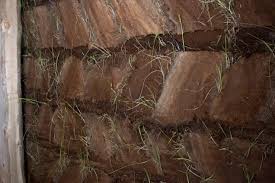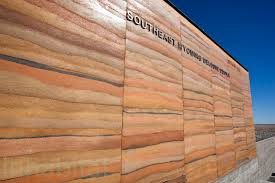 The Sami (indigenous skandinavian) build Gamme or Goahti (turf homes). The frame is birch roundwood pegged together with wood pens covered with poles. On those overlapping sheets of birch bark, kept in place by turf stacked against the sloping walls. In Staloluokta, Sweden even a small church is constructed this way.
The Sami (indigenous skandinavian) build Gamme or Goahti (turf homes). The frame is birch roundwood pegged together with wood pens covered with poles. On those overlapping sheets of birch bark, kept in place by turf stacked against the sloping walls. In Staloluokta, Sweden even a small church is constructed this way.
Rammed earth, also known as taipa (Portuguese), tapial (Spanish), and pisé (de terre) (French), is a technique for building walls with local, natural and organic earth, chalk, lime or gravel. It is mixed and compacted in a formwork and then layered in blocks. This ancient building method knows a revival in the search for more sustainable building materials . Rammed-earth walls are simple to construct, noncombustible, thermally massive, strong, and durable. (More information on this centuries old, worldwide used technique to build house and temples you can find under Rammed Earth.)
Architects Herzog & de Meuron and Lehm Ton Erde (Loam Clay Earth) made in 2013-2014 Europe’s Largest Rammed Earth Building, the Kräuterzentrum (herbs center) for herbal sweet manufacturer Ricola in Laufen (Basel), Switzerland. It measures 111 x 28,9 x 10,8 meters.
 The use is like building sandcastles. The material should be moist so you can squeeze it between your hands into a ball. But not wet, because then it becomes liquid and muddy, and it is not compactable. The mixture may contain up to 75% sand, depending on the quality and the proportion of clay and loam. Usually as a form a slidable mold is used which in each case is placed on a pre-drying section of a wall.
The use is like building sandcastles. The material should be moist so you can squeeze it between your hands into a ball. But not wet, because then it becomes liquid and muddy, and it is not compactable. The mixture may contain up to 75% sand, depending on the quality and the proportion of clay and loam. Usually as a form a slidable mold is used which in each case is placed on a pre-drying section of a wall.
Build in a dry place to avoid rising groundwater. Use a stone foundation that serves as a water barrier. (Today, we use concrete for this. Modern buildings use cement in the mixture. As a result, the structure is strong, but she is no longer sustainable.)
Also parts of the 2,000 year old Chinese wall are built this way.
Finishing is done with a sufficiently broad overhanging roof to keep the wall dry. Plastering is done with sufficiently wet clay.
